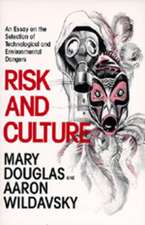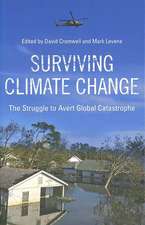Assessment of the Fate and Effects of Toxic Agents on Water Resources: Nato Security through Science Series C:
Editat de I. Ethem Gonenc, Vladimir G. Koutitonsky, Brenda Rashleigh, Robert B. Jr Ambrose, John P. Wolflinen Limba Engleză Hardback – 20 feb 2007
| Toate formatele și edițiile | Preț | Express |
|---|---|---|
| Paperback (1) | 2094.54 lei 43-57 zile | |
| SPRINGER NETHERLANDS – 8 feb 2007 | 2094.54 lei 43-57 zile | |
| Hardback (1) | 1828.29 lei 43-57 zile | |
| SPRINGER NETHERLANDS – 20 feb 2007 | 1828.29 lei 43-57 zile |
Din seria Nato Security through Science Series C:
- 18%
 Preț: 1210.63 lei
Preț: 1210.63 lei - 18%
 Preț: 1218.53 lei
Preț: 1218.53 lei - 18%
 Preț: 1819.77 lei
Preț: 1819.77 lei - 15%
 Preț: 654.62 lei
Preț: 654.62 lei - 18%
 Preț: 952.09 lei
Preț: 952.09 lei - 18%
 Preț: 1219.77 lei
Preț: 1219.77 lei - 18%
 Preț: 1221.38 lei
Preț: 1221.38 lei - 18%
 Preț: 1819.90 lei
Preț: 1819.90 lei - 18%
 Preț: 1818.65 lei
Preț: 1818.65 lei - 18%
 Preț: 946.55 lei
Preț: 946.55 lei - 18%
 Preț: 1220.12 lei
Preț: 1220.12 lei - 15%
 Preț: 644.18 lei
Preț: 644.18 lei - 18%
 Preț: 1215.70 lei
Preț: 1215.70 lei - 18%
 Preț: 1213.34 lei
Preț: 1213.34 lei - 18%
 Preț: 955.56 lei
Preț: 955.56 lei - 18%
 Preț: 1222.01 lei
Preț: 1222.01 lei - 18%
 Preț: 2094.54 lei
Preț: 2094.54 lei - 18%
 Preț: 1390.11 lei
Preț: 1390.11 lei - 15%
 Preț: 647.73 lei
Preț: 647.73 lei - 18%
 Preț: 1819.46 lei
Preț: 1819.46 lei - 24%
 Preț: 1596.81 lei
Preț: 1596.81 lei - 18%
 Preț: 1213.34 lei
Preț: 1213.34 lei - 18%
 Preț: 1821.51 lei
Preț: 1821.51 lei - 18%
 Preț: 1834.44 lei
Preț: 1834.44 lei
Preț: 1828.29 lei
Preț vechi: 2229.62 lei
-18% Nou
Puncte Express: 2742
Preț estimativ în valută:
349.83€ • 366.24$ • 289.47£
349.83€ • 366.24$ • 289.47£
Carte tipărită la comandă
Livrare economică 07-21 aprilie
Preluare comenzi: 021 569.72.76
Specificații
ISBN-13: 9781402055263
ISBN-10: 1402055269
Pagini: 432
Ilustrații: XVIII, 390 p.
Dimensiuni: 155 x 235 x 35 mm
Greutate: 0.78 kg
Ediția:2007
Editura: SPRINGER NETHERLANDS
Colecția Springer
Seria Nato Security through Science Series C:
Locul publicării:Dordrecht, Netherlands
ISBN-10: 1402055269
Pagini: 432
Ilustrații: XVIII, 390 p.
Dimensiuni: 155 x 235 x 35 mm
Greutate: 0.78 kg
Ediția:2007
Editura: SPRINGER NETHERLANDS
Colecția Springer
Seria Nato Security through Science Series C:
Locul publicării:Dordrecht, Netherlands
Public țintă
ResearchCuprins
Contents.Preface. Acknowledgements.1.Introduction..- 2. Decision-Making in Rapid Assessment and Diagnosis CBRN Effects on Coastal Lagoons.- Introduction. Decision-making in Rapid Assessment and Response. . Inventory information, processes, and infrastructures.Decision-making tools. Modeling.Graphical user interfaces.Monitoring.Indicators.Assessment tools.. Environmental Sensitivity Index (ES!).Social Impact Assessment (SIA).. Environmental Assessment (EA).SEA Toolkit. Decision-making approach (model).Classical rational decision making model.Organizational process model.Bureaucratic politic model.Decision-making process for rapid assessment. Development and implementation of a response plan (RP).Steps in the response planning process.Roles and responsibilities.Case Studies. Preparation of a Continuity of Operations Plan. Conclusion. References.3. Physical Processes and Modeling. Physical Processes in Lagoons.- Introduction.External Conditions – Part I. System of coordinates: the rotating Earth.Main external forcing.Gravity.Tides. Buoyancy. Winds.. Atmospheric gyres. Local winds.Radiation.Solar Radiation.Water properties.Structure of water molecule.Water density. Internal Structure and Water Dynamics - Part II. Stratification.Seasonal cycle of water stratification.Wind-induced motions.Water exchange with the sea, tides, river inflows.Gravity currents.Coupling physics and other rocesses.Conclusions.Important conclusions of External Conditions.Important conclusions of Internal Structure and Water Dynamics.Concluding remarks. References. Hydrodynamic Equations.- Introduction.The Eulerian and the Lagrangian view.Conservation Laws.Conservation of mass. Conservation of momentum. The Euler equations.The Euler equations in a rotating frame of reference. The Navier-Stokes equations. Conservation of energy.Conservation of salt. Equation of state. Simplifications and Scale Analysis. Incompressibility. The hydrostatic approximation.The Coriolis force.The Reynolds equations.The primitive equations.The Shallow Water Equations. Boundary Processes. Initial conditions.Material boundary conditions. Open boundaries conditions. Conditions on the sea surface and the bottom.References.Monitoring Physical Processes.- Introduction.Definition and Objectives of Environmental Monitoring.Multi-purposefulness of Monitoring Activity.Types of Monitoring. Baseline and Targeted Monitoring from a View of System Approach.Monitoring Parameters.Spatial Schemes of Monitoring.Types of Monitoring Measurements .Temporal Schedule of Monitoring. Monitoring and Short-term Data Collection Dedicated to Modeling.References. Time Series Analysis of Lagoon Variables.- Introduction.Lagoon Time Series.Time Series Preprocessing.Time Domain Analysis.Filters. Frequency Domain Analysis. Spectral analysis. Harmonic analysis.Summary. Discretization Techniques.- Introduction.The Basics. Discretization.Requirements.The Decay Equation — A Simple Example.Basic discretization formulas. Accuracy. Stability. Inertial Motion — A System of Equations. Matrices and Eigen values.Various schemes. The Diffusion Equation — The Spatial Dimensio.First and second spatial derivative. Explicit and implicit schemes.Stability The von Neuman stability analysis.The Transport Equation.The FTCS scheme. The forward and backward scheme.The propagation cone.The leap frog scheme.Final thoughts.Gravity Waves. Staggered schemes.Stability of schemes.The shallow water equations.Conclusions. Numerical Models as Decision Support Tools in Coastal Areas Decision Support Tools.- Decision Support Tools. Brief History of Modelling Tools. MOHID. MOHID: A Modular System. Model Module. Introduction.Single model.Nested models. Bathymetry module.Geometry module.Finite volume.Vertical coordinates. Hydrodynamic module. Open boundary conditions. Moving boundaries. Lagrangian module.Tracer concept. Tracer movement. Turbulent diffusion. Monitoring boxes.Oil module. Implementation .Oil-beaching.Removal techniques. Waterproperties module.Water quality module. Surface module.Wind.Heat fluxes.Solar radiation.Bottom module.Free vertical movement module.Hydrodynamic file module. References. 4. Effects pf CRBN Agents on Aquatic Ecosystems. Ecosystem approach for adaptive management of the coastal socio-ecological complexes.- Introduction.Processes and Functions.Functional Values and Socio-Economic Valuation.Lower Danube Wetlands System Case study.Conclusions.References.Developing the D-P-S-I-R framework of indicators for management of human impact on marine ecosystems: Baltic Sea example.- Introduction.The Conceptual Frameworks of Environmental Quality Indicators and Indices.Examples of P-S-R Indicators for the Main Environmental Concerns.Eutrophication.Fishery. Contamination by harmful substances. Oil pollution/marine transport.Invasion of non-indigenous species.Sanitary pollution. Dredge spoils dumping.Extraction of sand and gravel.Offshore oil and gas production. Artificial radionuclides.Coastal degradation. Loss ofbiodiversity and habitat destruction.Illustrative Examples of D-type Indicators.Summary and conclusions. References. Phytoplankton Ecological Processes for Ecosystem Modeling: Some Basic Concepts.- Introduction.Phytoplankton Systematics and Functional Diversity. Environmental Factors Controlling Phytoplankton Biomass.Size as an Alternative State Variable.Further Readings.Modeling Possible Impacts of Terrorist Attacks in Coastal Lagoon Ecosystems with Stella.- Ecosystem Organization.Food webs.Keystone species and reproductive strategies.Mature ecosystems vs. developmental stages.Ecosystem Succession.Pollutants and Bioamplification.Coastal lagoons and Water Renewal Rate.Terrorist Attack Consequences in the Lagoon Ecosystem. Outlines for Modeling.Ecological Modeling with Stella.Model Development. Exponential growth model. Logistic growth model. Competition model.Predation model. Simulation of Different Scenarios.Remarks. References.Trophic Network Models and Prediction of Toxic Substances Accumulation in Food Webs.- Introduction. Bioaccumulation of Toxic Substances in Food Webs.Bioaccumulation Web Models.ECOPATH. ECOSIM.ECOTRACE. References Assessment of Lake Ecosystem Response to Toxic Events with the AQUATOX Model.- Introduction. The AQUATOX Model. General AQUATOX Model Results: Factors Determining the Aquatic Ecosystem Response. Characteristics of Fish Species.Timing and Amount of the Chemical.Coralville Reservoir Example.Summary. References. Chemical Weapons Dumped in the Baltic Sea.- Introduction. Short history of use of chemical weapons. Classification and properties of chemical warfare agents.Chemical warfare agents in the marine environment.Chemical Weapon. Classification of chemical ammunition. Dumping the chemical weapon in the world ocean.Chemical weapon dumped in the Baltic Sea.Immediate effects after dumping.Selected Cases of Contacts with Chemical Munitions in the Baltic Sea Area.Injuries of children, 1955.Injuries of fishermen, 1997.Research on Dumped Chemical Weapon in the Baltic Sea.Results of German studies, 1994-1996.Results of Russian research, 2001. Results of studies in other countries. New/ongoing research projects.Lessons Learned from Unintentional Human Contact with Dumped Chemical Munitions. Designing Research on Dumped Chemical Weapon.Conclusions and Comments.References. Monitoring After Attack;
N. N. Kazantseva.- Introduction.Critical Points.Chemical and Biological Monitoring and Detection.5. Case Study: Dieldrin Attach in Dalyan Lagoon.- Background.Attack Scenario.Description of Dalyan Lagoon. Organization of teams.Tools and Techniques. The WASP7 Surface Water Body Model.The AQUATOX Surface Water Ecology Model.The Environmental Fluid Dynamics Code, EFDC.Results and Discussion.WASP7 Simulation Results. AQUATOX Simulation Results.Results from Emergency Response Team.Conclusions and Recommendations.Conclusions from student teams.Post-mortem analysis of exercise.Final remarks.References.Appendix 1.Appendix 2. List of Participants.
N. N. Kazantseva.- Introduction.Critical Points.Chemical and Biological Monitoring and Detection.5. Case Study: Dieldrin Attach in Dalyan Lagoon.- Background.Attack Scenario.Description of Dalyan Lagoon. Organization of teams.Tools and Techniques. The WASP7 Surface Water Body Model.The AQUATOX Surface Water Ecology Model.The Environmental Fluid Dynamics Code, EFDC.Results and Discussion.WASP7 Simulation Results. AQUATOX Simulation Results.Results from Emergency Response Team.Conclusions and Recommendations.Conclusions from student teams.Post-mortem analysis of exercise.Final remarks.References.Appendix 1.Appendix 2. List of Participants.
Caracteristici
Multidisciplinary approaches for rapid diagnoses and assessments Step-by-step treatment of all aspects of ecosystem processes, modelling and monitoring All aspects of the science required to understand the functioning of a coastal system tio assess CBRN Agents Effects on Water Resources Both science and management issues are discussed The illustration of issues discussed throughout the book with detailed case study










